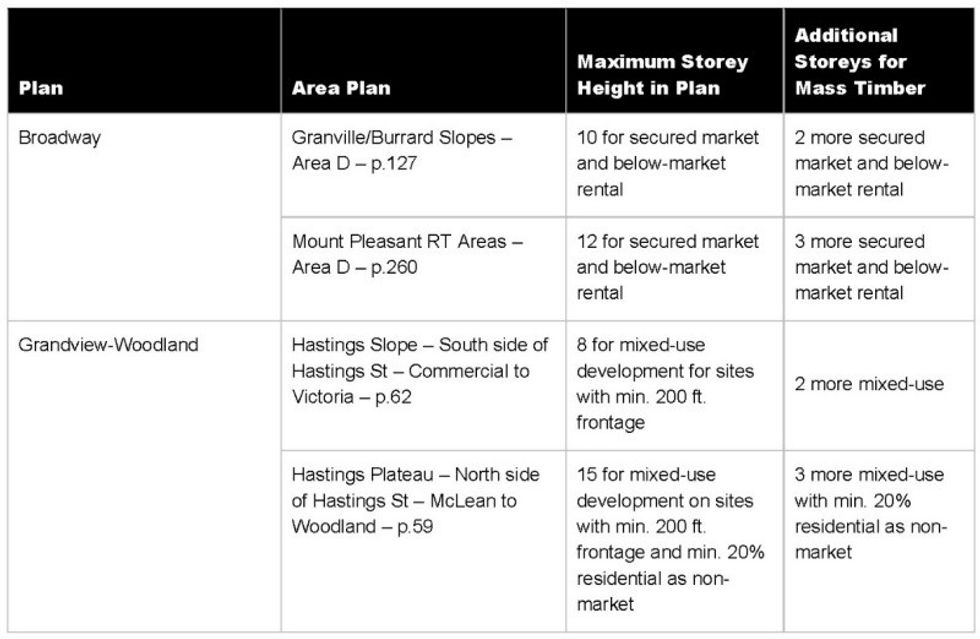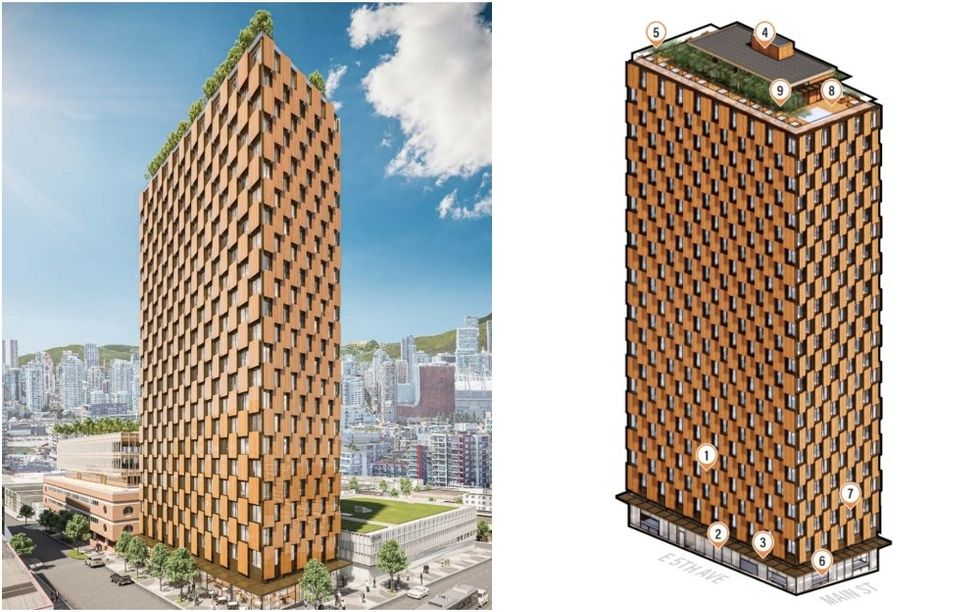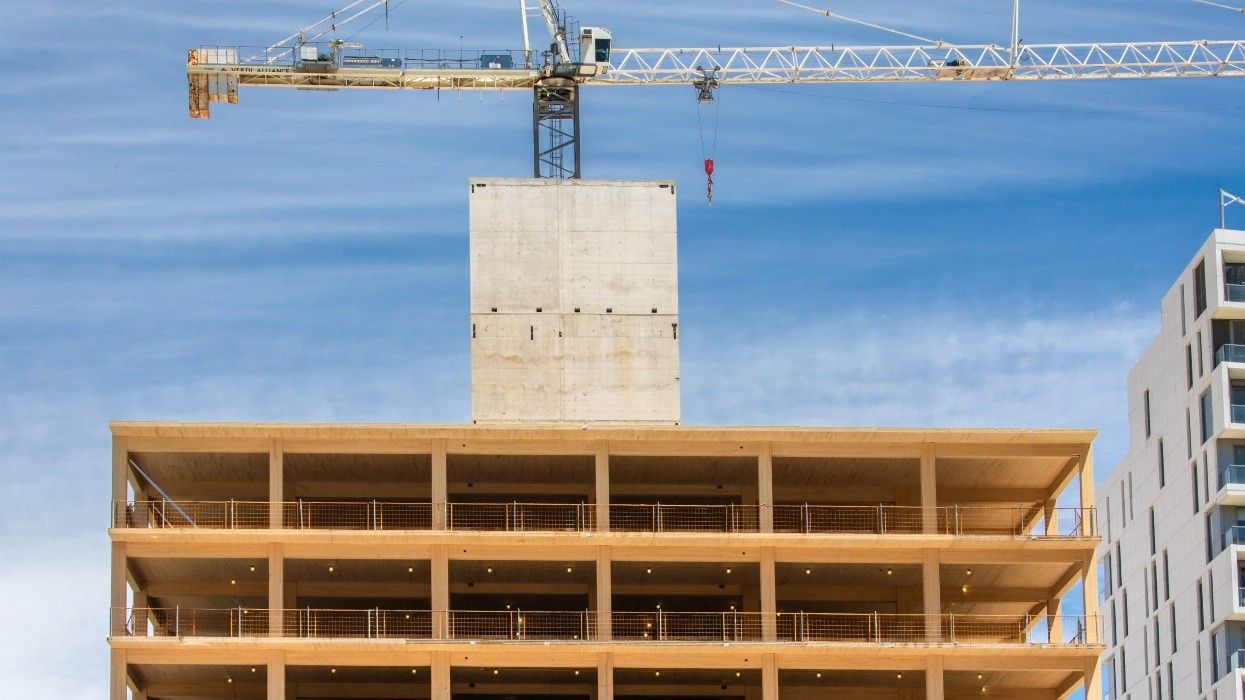On Tuesday, Vancouver City Council took its first steps towards creating a new policy program to "remove barriers to mass timber" and encourage more developers to utilize the building form.
The proposed Mass Timber Policy for Rezonings would allow additional height and density through the rezoning process, allowing up to two additional storeys on sites that currently allow for eight to 11 storeys, and up to three additional storeys on sites that currently allow for 12 or more storeys.
The City says it conducted consultations with developers, development consultants, and architects and that additional density was "one of the most compelling incentives" that was identified.
Projects that take advantage of the incentives must still meet the use and tenure requirements specified in the area plan, and other factors such as urban design considerations, view cones, and shadow impacts will still be evaluated and considered by the City.
For projects that are not seeking rezoning, the City's policies currently allow the Director of Planning to increase the allowable height by 6% to accommodate mass timber construction. Staff are recommending that this be increased to 10% and that it be allowable outright rather than through a conditional review process.
"This change provides an incentive for sites that are not undergoing a rezoning process," City staff said in a report to Council. "Making the regulation outright also increases certainty for proponents at the earliest stages of the process."

As well, the City will provide additional support to those looking to utilize mass timber construction on a new project. Staff from the Development Planning, Building, and Project Facilitation groups will convene for consultation during the development enquiry stage, before an application is officially submitted, which the City says is a response to those in the industry who said the "uncertainty of entering into the permit process with a new building form" was something that offset the advantages of using mass timber construction.
"This early access to expertise is intended to mitigate the uncertainty and complexity around building with a relatively new form of construction," City staff said. "Staff in relevant departments across the City would also be trained in mass timber construction in order to help develop expertise and familiarity with this type of building."
On Tuesday, Vancouver City Council approved the recommendations from staff to forward the proposed Mass Timber Policy for Rezonings to a public hearing to be held at a later date.
The State of Mass Timber Construction In BC
The potential new incentives from the City of Vancouver come less than two months after the provincial government announced that it will raise the current 12-storey limit on mass timber buildings to 18 storeys, under BC's building code, in hopes that the change will "expand the use of mass timber to build taller buildings and to make stronger communities." (The City of Vancouver says it will adopt the provincial change and also allow mass timber to be used on firewalls and walls on the lot line later this year.)
The two moves coming within a short period of time seems to indicate a collective increased focus on mass timber.
"Kudos to the Province for going to 18 storeys; I think that's where it should've been," says Rocky Sethi, who has been working with wood construction for 25 years and is currently the Managing Director of Stryke Group. "But what I would love to see is the Province say 'Okay, for the next 10 shovel-ready buildings, we're gonna give you x-amount of money.' Let's really re-invest in our province and try to give people the financial incentive. Perhaps you can require them to use a local supplier. I think that would be a great story, because those local suppliers are also using regional wood products, so you're stimulating the economy in a different way."
Eric Andreasen, VP of Sales and Marketing at Adera Development, which has been a strong advocate for mass timber — to the point of developing their own mass timber system called SmartWood — says that Adera is very excited that the City of Vancouver is taking mass timber seriously and that he believes it will move the needle.
"I think one of the significant obstacles for developers to craft product out of mass timber is how much they can actually put on a site," he says. "Six-storey buildings tend to be long and they tend to have a bunch of different facets that happen at the ground level, but when you're going up, it gets to be more of a primitive structure and it makes it a little more cost-effective than stuff at six storeys. It becomes simplified as you go up versus when you go lateral."
A big determining factor in construction is, of course, the costs. Andreasen says that concrete construction can be as much as 30% more expensive than traditional wood-frame construction, but that mass timber construction is more expensive than traditional wood-frame construction just because there's more wood involved. He says that part of what makes mass timber expensive is also the supply of mass timber.
In 2022, the Province introduced its Mass Timber Action Plan — the development of which was led by now-Minister of Housing Ravi Kahlon — and BC is home to several notable mass timber product suppliers who have been involved in projects around North America, such as StructureCraft and Kalesnikoff, so BC has a solid mass timber industry. Whether or not our local industry can meet a rise in demand in mass timber construction is a fair question, though, says both Sethi and Andreasen.
"I think there was definitely a scare with Structurlam going out of business," says Sethi, who was also formerly the COO at Adera for six years before leaving last year. "There continues to be concern around lack of trade resources who able to build/assemble these buildings, and also some [concern] about municipalities that are not friendly towards innovation. That's probably the lowest on the list, but there's definitely a component of that for sure."
"I think all of the suppliers right now are aware of the demand that's coming and they're trying to do everything they can," says Andreasen. "Timber management and how it relates to communities that are in those types of areas — I think there are a lot management questions, but I do believe that everyone is working on that right now and that, as necessary, you're going to see the establishment of increased capacity and new operations coming to North America."

For consumers, both Andreasen and Sethi believe that there are some misconceptions about mass timber.
"If I'm going to be honest, I do believe that people think wood burns," says Andreasen. "But it's like taking a blowtorch to a tree. You can't burn it down. It's not going to light on fire. You need to get up into the branches. You can burn the leaves off, but it's still alive and, well, like the 150-year-old banyan tree in Hawaii. People think wood burns, but mass timber doesn't have enough surface area fuel. We've done multiple fire tests on it and it functions after a fire, whereas steel and concrete don't."
Another misconception Andreasen points to is the perception of concrete as being more luxurious, which he says is primarily because concrete is used for high-rises and people associate those high elevations with luxury. He adds that mass timber product also functions and performs just as good as concrete products, if not better, not to mention it's substantially better for the environment and makes for a faster and smoother construction process.
"There's definitely some misconceptions or lack of understanding out there, but I think people are starting to get it," Sethi says. "I think people have gotten over the fear side of things and it's more about technical questions — the supply side, what are the acoustics like — and those are better questions and those are people trying to learn about the products."
Andreasen says that Adera's mass timber projects have all been six storeys or lower, but that they are currently planning a 12-storey building and are also actively looking for 12-storey sites.
"Mass timber is coming. There's no way that we can stop it. We have a requirement for it in terms of sustainable practices and in terms of a better method of building, and I believe that's what it is. More people need to talk about it, I think the conversation needs to be had everywhere. One way or another, it's going to come and it's just a question of getting ready to accept it, and that's from consumers all the way to the approvers."
- "100 Small Things": How The Stack and M5 Prototype Got to Zero Carbon ›
- A Renowned Architect, $10M, And Mass Timber. The Project: A Sales Centre ›
- STOREYS' 2022 Design Trend of the Year: Mass Timber ›
- Construction Associations Push BC To Create Ministry Of Construction ›
- Ontario Now Allows Mass Timber Buildings Up To 18 Storeys ›





















